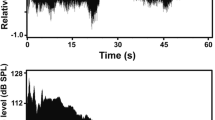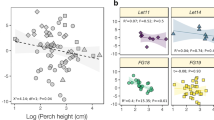Abstract
Invasive species can disrupt the communication systems that native biota use for reproductive interactions. In tropical Australia, invasive cane toads (Rhinella marina) breed in many of the same waterbodies that are used by native frogs, and males of both the invader and the native taxa rely on vocal signals to attract mates. We conducted playback experiments to test the hypothesis that calls of toads may influence the calling behaviour of frogs (Limnodynastes convexiusculus and Litoria rothii). Male L. convexiusculus adjusted their calling rate and the variance in inter-call interval in response to a variety of sounds, including the calls of cane toads as well as those of other native frog species, and other anthropogenic noise, whereas L. rothii did not. Within the stimulus periods of playbacks, male L. convexiusculus called more intensely during long silent gaps than during calling blocks. Thus, males of one frog species reduced their calling rate, possibly to minimise energy expenditure during periods of acoustic interference generated by cane toads. In spite of such modifications, the number of overlapping calls (within stimulus periods) did not differ significantly from that expected by chance. In natural conditions, the calls of cane toads are continuous rather than episodic, leaving fewer gaps of silence that male frogs could exploit. Future work could usefully quantify the magnitude of temporal (e.g. diel and seasonal) and spatial overlap between calling by toads and by frogs and the impact of call-structure shifts on the ability of male frogs to attract receptive females.





Similar content being viewed by others
References
Bee MA, Perrill SA, Owen PC (2000) Male green frogs lower the pitch of acoustic signals in defense of territories: a possible dishonest signal of size? Behav Ecol 11:169–177
Beckmann C, Crossland M, Shine R (2011) Responses of Australian wading birds to a novel toxic prey type, the invasive cane toad Rhinella marina. Biol Invasions 13:2925–2934
Bosch J, Marquez R (2000) Acoustical interference in the advertisement calls of the midwife toads (Alytes obstetricans and Alytes cisternasii). Behaviour 137:249–263
Both C, Grant T (2012) Biological invasions and the acoustic niche: the effect of bullfrog calls on the acoustic signals of white-banded tree frogs. Biol Lett 8:714–716
Byers JE, Wright JT, Gribben PE (2010) Variable direct and indirect effects of a habitat-modifying invasive species on mortality of native fauna. Ecology 91:1787–1798
Cunnington GM, Fahrig L (2010) Plasticity in the vocalizations of anurans in response to traffic noise. Acta Oecol Int J Ecol 36:463–470
D'Amore A, Kirby E, McNicholas M (2009) Invasive species shifts ontogenetic resource partitioning and microhabitat use of a threatened native amphibian. Aquat Conserv 19:534–541
Duellman W, Trueb L (1986) Biology of amphibians. McGraw-Hill Inc., Baltimore, Maryland
Gerhardt HC (1991) Female mate choice in treefrogs: static and dynamic acoustic criteria. Anim Behav 42:615–635
Gerhardt HC, Huber F (2002) Acoustic communication. In: Insects and anurans: common problems and diverse solutions. University of Chicago Press, Chicago, Illinois
Gordon HR, Thomas HF (1992) The impact of the introduction of the colubrid snake Boiga irregularis on Guam's lizards. J Herpetol 26:166–174
Greenlees MJ, Phillips BL, Shine R (2010) Adjusting to a toxic invader: native Australian frogs learn not to prey on cane toads. Behav Ecol 21:966–971
Halfwerk W, Holleman LJM, Lessells CM, Slabbekoorn H (2011) Negative impact of traffic noise on avian reproductive success. J Appl Ecol 48:210–219
Holway DA, Suarez AV (1999) Animal behavior: an essential component of invasion biology. Trends Ecol Evol 14:328–330
Johnson LS, Searcy WA (1996) Female attraction to male song in house wrens (Troglodytes aedon). Behaviour 133:357–366
Kaiser K, Hammers JL (2009) The effect of anthropogenic noise on male advertisement call rate in the neotropical treefrog, Dendropsophus triangulum. Behaviour 146:1053–1069
Lengagne T (2008) Traffic noise affects communication behaviour in a breeding anuran, Hyla arborea. Biol Conserv 141:2023–2031
Letnic M, Webb JK, Shine R (2008) Invasive cane toads (Bufo marinus) cause mass mortality of freshwater crocodiles (Crocodylus johnstoni) in tropical Australia. Biol Conserv 141:1773–1782
Levin DA (2003) Ecological speciation: lessons from invasive species. Syst Bot 28:643–650
Littlejohn MJ, Martin AA (1969) Acoustic interaction between two species of leptodactylid frogs. Anim Behav 17:785–791
Llusia D, Gómez M, Penna M, Márquez R (2013) Call transmission efficiency in native and invasive anurans: competing hypotheses of divergence in acoustic signals. PLoS ONE 8:e77312
Mack RN, Simberloff D, Lonsdale WM, Evans H, Clout M, Bazzaz FA (2000) Biotic invasions: causes, epidemiology, global consequences, and control. Ecol Appl 10:689–710
Martinez-Rivera CC, Gerhardt HC (2008) Advertisement-call modification, male competition, and female preference in the bird-voiced treefrog Hyla avivoca. Behav Ecol Sociobiol 63:195–208
McGregor PK, Catchpole CK, Dabelsteen T et al. (1992) Design of playback experiments: the Thornbridge Hall BATO ARW Consensus. In: McGregor PK (ed) Playback and studies of animal communication. NATO ASI Series A: Life Sciences, New York
Nelson DWM, Crossland MR, Shine R (2011) Foraging responses of predators to novel toxic prey: effects of predator learning and relative prey abundance. Oikos 120:152–158
Owen PC, Gordon NM (2005) The effect of perceived intruder proximity and resident body size on the aggressive responses of male green frogs, Rana clamitans (Anura : Ranidae). Behav Ecol Sociobiol 58:446–455
Parris KM, Velik-Lord M, North JMA, Function L (2009) Frogs call at a higher pitch in traffic noise. Ecol Soc 14:25 (online). http://www.ecologyandsociety.org/vol14/iss1/art25/
Penna M, Velasquez N (2011) Heterospecific vocal interactions in a frog from the southern temperate forest, Batrachyla taeniata. Ethology 117:63–71
Phillips BL, Brown GP, Greenlees M, Webb JK, Shine R (2007) Rapid expansion of the cane toad (Bufo marinus) invasion front in tropical Australia. Aust Ecol 32:169–176
Pizzatto L, Shine R (2009) Native Australian frogs avoid the scent of invasive cane toads. Aust Ecol 34:77–82
Polo-Cavia N, Lopez P, Martin J (2009) Interspecific differences in chemosensory responses of freshwater turtles: consequences for competition between native and invasive species. Biol Invasions 11:431–440
Pröhl H (2003) Variation in male calling behaviour and relation to male mating success in the strawberry poison frog (Dendrobates pumilio). Ethology 109:273–290
Rebar D, Bailey NW, Zuk M (2009) Courtship song's role during female mate choice in the field cricket Teleogryllus oceanicus. Behav Ecol 20:1307–1314
Sax DF, Stachowicz JJ, Brown JH, Bruno JF, Dawson MN, Gaines SD, Grosberg RK, HastingS A, Holt RD, Mayfield MM, O'Connor MI, Rice WR (2007) Ecological and evolutionary insights from species invasions. Trends Ecol Evol 22:465–471
Schwartz JJ, Wells KD (1983) An experimental study of acoustic interference between two species of neotropical treefrogs. Anim Behav 31:181–190
Semeniuk M, Lemckert F, Shine R (2007) Breeding-site selection by cane toads (Bufo marinus) and native frogs in northern New South Wales, Australia. Wildl Res 34:59–66
Shine R (2010) The ecological impact of invasive cane toads (Bufo marinus) in Australia. Q Rev Biol 85:253–291
Shine R (2014) A review of ecological interactions between native frogs and invasive cane toads in Australia. Aust Ecol 39:1–16
Shine R, Brown GP (2008) Adapting to the unpredictable: reproductive biology of vertebrates in the Australian wet-dry tropics. Philos Trans Roy Soc B 363:363–373
Sun JWC, Narins PA (2005) Anthropogenic sounds differentially affect amphibian call rate. Biol Conserv 121:419–427
Trompeter WP, Langkilde T (2011) Invader danger: lizards faced with novel predators exhibit an altered behavioral response to stress. Horm Behav 60:152–158
Tyler MJ, Knight F (2009) Field guide to the frogs of Australia. CSIRO Publishing, Collingwood, Victoria
Urban MC, Phillips BL, Skelly DK, Shine R (2007) The cane toad's (Chaunus Bufo marinus) increasing ability to invade Australia is revealed by a dynamically updated range model. Proc R Soc Lond B 274:1413–1419
Usio N, Konishi M, Nakano S (2001) Species displacement between an introduced and a 'vulnerable' crayfish: the role of aggressive interactions and shelter competition. Biol Invasions 3:179–185
Webb JK, Brown GP, Child T, Greenlees MJ, Phillips BL, Shine R (2008) A native dasyurid predator (common planigale, Planigale maculata) rapidly learns to avoid a toxic invader. Aust Ecol 33:821–829
Wells KD (2001) The energetics of calling in frogs. In: Ryan MJ (ed) Anuran communication. Smithsonian Institution, Washington, pp 45–60
Wells KD, Schwartz JJ (2007) The behavioral ecology of anuran communication. In: Hearing and sound communication in amphibians, vol 28. Springer, New York, pp 44-86
Wiley RH (2006) Signal detection and animal communication. Adv Stud Behav 36:217–247
Wojcieszek JM, Nicholls JA, Marshall NJ, Goldizen AW (2006) Theft of bower decorations among male Satin Bowerbirds (Ptilonorhynchus violaceus): why are some decorations more popular than others? EMU 106:175–180
Wollerman L, Wiley RH (2002) Background noise from a natural chorus alters female discrimination of male calls in a Neotropical frog. Anim Behav 63:15–22
Wong S, Parada H, Narins PM (2009) Heterospecific acoustic interference: effects on calling in the frog Oophaga pumilio in Nicaragua. Biotropica 41:74–80
Zelick RD, Narins PM (1982) Analysis of acoustically evoked call suppression behaviour in a neotropical treefrog. Anim Behav 30:728–733
Zhou HC, Du JW, Huang YP (2005) Effects of sublethal doses of malathion on responses to sex pheromones by male Asian corn borer moths, Ostrinia furnacalis (Guenee). J Chem Ecol 31:1645–1656
Acknowledgments
The Northern Territory Land Corporation provided facilities for the study. Dave Armstrong, Lucy Hurlstone, Jerry Hemphill and the staff of Beatrice Hill Farm allowed us access to their properties for the study. We thank Melanie Elphick for her assistance with manuscript preparation, and two anonymous reviewers for their helpful comments. This work was supported by the Australian Research Council.
Ethical standards
The research was in compliance with ethical guidelines and the current laws of Australia. Anurans were studied under protocols approved by the USYD Animal Ethics Committee and Parks and Wildlife Commission of the Northern Territory.
Author information
Authors and Affiliations
Corresponding author
Additional information
Communicated by M. Gibbons
Electronic supplementary material
Below is the link to the electronic supplementary material.
ESM 1
(TIFF 493 kb)
Rights and permissions
About this article
Cite this article
Bleach, I.T., Beckmann, C., Both, C. et al. Noisy neighbours at the frog pond: effects of invasive cane toads on the calling behaviour of native Australian frogs. Behav Ecol Sociobiol 69, 675–683 (2015). https://doi.org/10.1007/s00265-015-1879-z
Received:
Revised:
Accepted:
Published:
Issue Date:
DOI: https://doi.org/10.1007/s00265-015-1879-z




